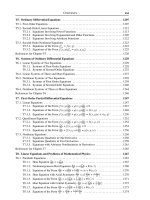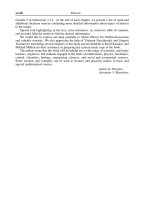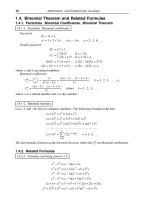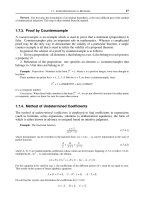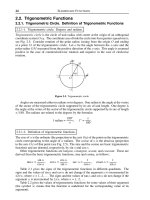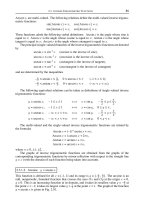Handbook of mathematics for engineers and scienteists part 31 docx
Bạn đang xem bản rút gọn của tài liệu. Xem và tải ngay bản đầy đủ của tài liệu tại đây (381.22 KB, 7 trang )
178 ALGEBRA
The integer r satisfying these two conditions is called the rank of the matrix A and is
denoted by r =rank(A). Any nonzero rth-order minor of the matrix A is called its basic
minor. The rows and the columns whose intersection yields its basic minor are called basic
rows and basic columns of the matrix. The rank of a matrix is equal to the maximal number
of its linearly independent rows (columns). This implies that for any matrix, the number of
its linearly independent rows is equal to the number of its linearly independent columns.
When calculating the rank of a matrix A, one should pass from submatrices of a smaller
size to those of a larger size. If, at some step, one finds a submatrix A
k
of size k × k
such that it has a nonzero kth-order determinant and the (k + 1)st-order determinants of all
submatrices of size (k +1)× (k +1) containing A
k
are equal to zero, then it can be concluded
that k is the rank of the matrix A.
Properties of the rank of a matrix:
1. For any matrices A and B of the same size the following inequality holds:
rank (A + B) ≤ rank (A)+rank(B).
2. For a matrix A of size m × n and a matrix B of size n × k,theSylvester inequality holds:
rank (A)+rank(B)–n ≤ rank (AB) ≤ min{rank (A), rank (B)}.
For a square matrix A of size n × n,thevalued = n –rank(A) is called the defect of the
matrix A,andA is called a d-fold degenerate matrix. The rank of a nondegenerate square
matrix A ≡ [a
ij
]ofsizen × n is equal to n.
T
HEOREM ON BASIC MINOR.
Basic rows (resp., basic columns) of a matrix are linearly
independent. Any row (resp., any column) of a matrix is a linear combination of its basic
rows (resp., columns).
5.2.2-4. Expression of the determinant in terms of matrix entries.
1
◦
. Consider a system of mutually distinct β
1
, β
2
, , β
n
, with each β
i
taking one of the
values 1, 2, , n. In this case, the system β
1
, β
2
, , β
n
is called a permutation of the set
1, 2, , n. If we interchange two elements in a given permutation β
1
, β
2
, , β
n
, leaving
the remaining n – 2 elements intact, we obtain another permutation, and this transformation
of β
1
, β
2
, , β
n
is called transposition. All permutations can be arranged in such an order
that the next is obtained from the previous by a single transposition, and one can start from
an arbitrary permutation.
Example 2. Let us demonstrate this statement in the case of n = 3 (there are n!=6 permutations).
If we start from the permutation 123, then we can order all permutations, for instance, like this (we
underline the numbers to be interchanged):
1
2 3 −→ 2 13−→ 3 1 2 −→ 1 32−→ 2 3 1 −→ 321.
Thus, from any given permutation of n symbols, one can pass to any other permutation
by finitely many transpositions.
One says that in a given permutation, the elements β
i
and β
j
form an inversion if β
i
> β
j
for i < j. The total number of inversions in a permutation β
1
, β
2
, , β
n
is denoted
by N(β
1
, β
2
, , β
n
). A permutation is said to be even if it contains an even number of
inversions; otherwise, the permutation is said to be odd.
Example 3. The permutation 45132(n = 5) contains N(45132)=7 inversions and is, therefore, odd.
Any of its transposition (for instance, that resulting in the permutation 43152) yields an even permutation.
The nth-order determinant of a matrix A ≡ [a
ij
]ofsizen × n can be defined as follows:
Δ ≡ det A =
β
1
,β
2
, ,β
n
(–1)
N(β
1
,β
2
, ,β
n
)
a
β
1
1
a
β
2
2
a
β
n
n
,
where the sum is over all possible permutations β
1
, β
2
, , β
n
of the set 1, 2, , n.
5.2. MATRICES AND DETERMINANTS 179
Example 4. Using the last formula, let us calculate the third-order determinant of the matrix from Exam-
ple 1. The numbers β
1
, β
2
, β
3
represent permutations of the set 1, 2, 3.Wehave
Δ ≡ det A =(–1)
N(1,2,3)
a
11
a
22
a
33
+(–1)
N(1,3,2)
a
11
a
32
a
23
+(–1)
N(2,1,3)
a
21
a
12
a
33
+(–1)
N(2,3,1)
a
21
a
32
a
13
+(–1)
N(3,1,2)
a
31
a
12
a
23
+(–1)
N(3,2,1)
a
31
a
22
a
13
=(–1)
0
×1×1×(–4)+(–1)
1
×1×(–1) ×5+(–1)
1
×6×(–1) × (–4)
+(–1)
2
×6×(–1) ×2+(–1)
2
×2×(–1) ×5+(–1)
3
×2×1×2=–49,
which coincides with the result of Example 1.
2
◦
.Thenth-order determinant can also be defined as follows:
Δ ≡ det A =
n
β
1
=1
n
β
2
=1
···
n
β
n
=1
δ
β
1
β
2
β
n
a
β
1
1
a
β
2
2
a
β
n
n
,
where δ
β
1
β
2
β
n
is the Levi-Civita symbol:
δ
β
1
β
2
β
n
=
0,ifsomeofβ
1
, β
1
, , β
n
coincide,
1,ifβ
1
, β
1
, , β
n
form an even permutation,
–1,ifβ
1
, β
1
, , β
n
form an odd permutation.
5.2.2-5. Calculation of determinants.
1
◦
. Determinants of specific matrices are often calculated with the help of the formulas
for row expansion or column expansion (see Paragraph 5.2.2-1). For this purpose, its is
convenient to take rows or columns containing many zero entries.
2
◦
. The determinant of a triangular (upper or lower) and a diagonal matrices is equal to the
product of its entries on the main diagonal. In particular, the determinant of the unit matrix
is equal to 1.
3
◦
. The determinant of a strictly triangular (upper or lower) matrix is equal to zero.
4
◦
. For block matrices, the following formula can be used:
AO
BC
=
AB
OC
=detA det C,
where A, B, C are square matrices of size n × n and O is the zero matrix of size n × n.
5
◦
.TheVandermonde determinant is the determinant of the Vandermonde matrix:
Δ(x
1
, x
2
, , x
n
) ≡
11··· 1
x
1
x
2
··· x
n
x
2
1
x
2
2
··· x
2
n
.
.
.
.
.
.
.
.
.
.
.
.
x
n–1
1
x
n–1
2
··· x
n–1
n
=
1≤j<i≤n
(x
i
– x
j
).
5.2.2-6. Determinant of a sum and a product of matrices.
The determinant of the product of two matrices A and B of the same size is equal to the
product of their determinants,
det(AB)=detA det B.
The determinant of the direct sum of a matrix A of size m × m and B of size n × n is
equal to the product of their determinants,
det(A ⊕ B)=detAdet B.
180 ALGEBRA
The determinant of the direct product of a matrix A of size m × m and B of size n × n
is calculated by the formula
det(A ⊗ B)=(detA)
n
(det B)
m
.
5.2.2-7. Relation between the determinant and the inverse matrix.
EXISTENCE THEOREM.
A square matrix
A
is invertible if and only if its determinant is
different from zero.
Remark. A square matrix A is nondegenerate if its determinant is different from zero.
The adjugate (classical adjoint) for a matrix A ≡ [a
ij
]ofsizen × n is a matrix C ≡ [c
ij
]
of size n×n whose entries coincide with the cofactors of the entries of the transpose A
T
, i.e.,
c
ij
= A
ji
(i, j = 1, 2, , n). (5.2.2.9)
The inverse matrix of a square matrix A ≡ [a
ij
]ofsizen × n is the matrix of size n × n
obtained from the adjugate matrix by dividing all its entries by det A, i.e.,
A
–1
=
⎛
⎜
⎜
⎜
⎝
A
11
det A
A
21
det A
···
A
n1
det A
A
12
det A
A
22
det A
···
A
n2
det A
.
.
.
.
.
.
.
.
.
.
.
.
A
1n
det A
A
2n
det A
···
A
nn
det A
⎞
⎟
⎟
⎟
⎠
.(5.2.2.10)
J
ACOBI THEOREM.
For minors of the matrix of cofactors of a matrix
A
, the following
relations hold:
A
i
1
j
1
A
i
1
j
2
··· A
i
1
j
k
A
i
2
j
1
A
i
2
j
2
··· A
i
2
j
k
.
.
.
.
.
.
.
.
.
.
.
.
A
i
k
j
1
A
i
k
j
2
··· A
i
k
j
k
=(detA)
k–1
A
i
1
i
2
i
k
j
1
j
2
j
k
.
5.2.3. Equivalent Matrices. Eigenvalues
5.2.3-1. Equivalence transformation.
Matrices A and
A of size m × n are said to be equivalent if there exist nondegenerate
matrices S and T of size m × m and n × n, respectively, such that A and
A are related by
the equivalence transformation
A = SAT.
T
HEOREM.
Two matrices of the same size are equivalent if and only if they are of the
same rank.
Remark 1. One of the square matrices S and T may coincide with the unit matrix. Thus, we have
equivalent matrices A and B if there is a nondegenerate square matrix S such that
A = SA or
A = AS.
Remark 2. Triangular decomposition of a matrix A corresponds to its equivalence transformation with
A ≡ I,sothatA = S
–1
T
–1
= LU,whereL = S
–1
and P = T
–1
are an upper and lower triangular matrix. This
representation is also called the LU-decomposition.
Any equivalence transformation can be reduced to a sequence of elementary transfor-
mations of the following types:
1. Interchange of two rows (columns).
2. Multiplication of a row (column) by a nonzero scalar.
3. Addition to some row (column) of another row (column) multiplied by a scalar.
5.2. MATRICES AND DETERMINANTS 181
These elementary transformations are accomplished with the help of elementary matri-
ces obtained from the unit matrix by the corresponding operations with its rows (columns).
With the help of elementary transformations, an arbitrary matrix A of rank r > 0 can be
reduced to normal (canonical) form, which has a block structure with the unit matrix I of
size r × r in the top left corner.
Example 1. The LU-decomposition of a matrix
A =
214
321
133
can be obtained with the help of the following sequence of elementary transformations:
S
1
1/200
010
001
214
321
133
→
S
2
100
–310
001
11/22
321
133
→
S
3
100
010
–101
11/22
01/2 –5
13 3
→
→
11/22
01/2 –5
05/21
T
1
1 –1/20
010
001
→
10 2
01/2 –5
05/21
T
2
10–2
01 0
00 1
→
→
S
4
100
020
001
10 0
01/2 –5
05/21
→
S
5
100
010
0 –5/21
10 0
01–10
05/21
→
→
10 0
01–10
00 26
T
3
10 0
0110
00 1
→
S
6
10 0
01 0
001/26
10 0
01 0
0026
→
100
010
001
.
These transformations amount to the equivalence transformation I = SAT,whereT = T
1
T
2
T
3
:
S = S
6
S
5
S
4
S
3
S
2
S
1
=
1/20 0
–32 0
7/26 –5/26 1/26
and T = T
1
T
2
T
3
=
1 –1/2 –7
0110
00 1
.
Hence, we obtain
L = S
–1
=
20 0
31/20
15/226
and U = T
–1
=
11/22
01–10
00 1
.
5.2.3-2. Similarity transformation.
Two square matrices A and
A of the same size are said to be similar if there exists a square
nondegenerate matrix S of the same size, the so-called transforming matrix, such that A
and
A are related by the similarity transformation
A = S
–1
AS or A = S
AS
–1
.
Properties of similar matrices:
1. If A and B are square matrices of the same size and C = A + B,then
C =
A +
B or S
–1
(A + B)S = S
–1
AS + S
–1
BS.
182 ALGEBRA
2. If A and B are square matrices of the same size and C = AB,then
C =
A
B or S
–1
(AB)S =(S
–1
AS)(S
–1
BS).
3. If A is a square matrix and C = λA where λ is a scalar, then
C = λ
B or S
–1
(λB)T = λS
–1
BS.
4. Two similar matrices have the same rank, the same trace, and the same determinant.
Under some additional conditions, there exists a similarity transformation that turns a
square matrix A into a diagonal matrix with the eigenvalues of A (see Paragraph 5.2.3-5) on
the main diagonal. There are three cases in which a matrix can be reduced to diagonal form:
1. All eigenvalues of A are mutually distinct (see Paragraph 5.2.3-5).
2. The defects of the matrices A–λ
i
I are equal to the multiplicities m
i
of the corresponding
eigenvalues λ
i
(see Paragraph 5.2.3-6). In this case, one says that the matrix has a simple
structure.
3. Symmetric matrices.
For a matrix of general structure, one can only find a similarity transformation that
reduces the matrix to the so-called quasidiagonal canonical form or the canonical Jordan
form with a quasidiagonal structure. The main diagonal of the latter matrix consists of the
eigenvalues of A, each repeated according to its multiplicity. The entries just above the
main diagonal are equal either to 1 or 0. The other entries of the matrix are all equal to zero.
The matrix in canonical Jordan form is a diagonal block matrix whose blocks form its main
diagonal, each block being either a diagonal matrix or a so-called Jordan cell of the form
Λ
k
≡
⎛
⎜
⎜
⎜
⎝
λ
k
10··· 0
0 λ
k
1 ··· 0
00λ
k
··· 0
.
.
.
.
.
.
.
.
.
.
.
.
.
.
.
000··· λ
k
⎞
⎟
⎟
⎟
⎠
.
5.2.3-3. Congruent and orthogonal transformations.
Square matrices A and
A of the same size are said to be congruent if there is a nondegenerate
square matrix S such that A and
A are related by the so-called congruent or congruence
transformation
A = S
T
AS or A = S
AS
T
.
This transformation is characterized by the fact that it preserves the symmetry of the
original matrix.
For any symmetric matrix A of rank r there is a congruent transformation that reduces
A to a canonical form which is a diagonal matrix of the form,
A = S
T
AS =
I
p
–I
r–p
O
,
where I
p
and I
r–p
are unit matrices of size p × p and (r – p) × (r –p). The number p is called
the index of the matrix A,ands = p –(r – p)=2p – r is called its signature.
T
HEOREM.
Two symmetric matrices are congruent if they are of the same rank and have
the same index (or signature).
A similarity transformation defined by an orthogonal matrix S (i.e., S
T
= S
–1
)issaid
to be orthogonal. In this case
A = S
–1
AS = S
T
AS.
5.2. MATRICES AND DETERMINANTS 183
Example 2. Consider a three-dimensional orthogonal coordinate system with the axes OX
1
, OX
2
, OX
3
and a new coordinate system obtained from this one by its rotation by the angle ϕ around the axis OX
3
, i.e.,
x
1
= x
1
cos ϕ – x
2
sin ϕ, x
2
= x
1
sin ϕ + x
2
cos ϕ, x
3
= x
3
.
The matrix of this coordinate transformation has the form
S
3
=
cos ϕ –sinϕ 0
sin ϕ cos ϕ 0
001
.
Rotations of the given coordinate system by the angles ψ and θ around the axes OX
1
and OX
2
, respectively,
correspond to the matrices
S
1
=
10 0
0 cos ψ –sinψ
0 sin ψ cos ψ
, S
2
=
cos θ 0 sin θ
010
–sinθ 0 cos θ
.
The matrices S
1
, S
2
, S
3
are orthogonal (S
–1
j
= S
T
j
).
The transformation that consists of simultaneous rotations around of the coordinate axes by the angles
ψ, θ, ϕ is defined by the matrix
S = S
3
S
2
S
1
.
5.2.3-4. Conjunctive and unitary transformations.
1
◦
. Square matrices A and
A of the same size are said to be conjunctive if there is a
nondegenerate matrix S such that A and
A are related by the conjunctive transformation
A = S
∗
AS or A = S
AS
∗
,
where S
∗
is the adjoint of S.
2
◦
. A similarity transformation of a matrix A is said to be unitary if it is defined by a unitary
matrix S (i.e., S
∗
= S
–1
). In this case,
A = S
–1
AS = S
∗
AS.
Some basic properties of the above matrix transformations are listed in Table 5.3.
TABLE 5.3
Matrix transformations
Transformation
A
Invariants
Equivalence
SAT
Rank
Similarity
S
–1
AS
Rank, determinant, eigenvalues
Congruent
S
T
AS
Rank and symmetry
Orthogonal
S
–1
AS = S
T
AS
Rank, determinant, eigenvalues, and symmetry
Conjunctive
S
∗
AS
Rank and self-adjointness
Unitary
S
–1
AS = S
∗
AS
Rank, determinant, eigenvalues, and self-adjointness
5.2.3-5. Eigenvalues and spectra of square matrices.
An eigenvalue of a square matrix A is any real or complex λ for which the matrix F (λ) ≡
A – λI is degenerate. The set of all eigenvalues of a matrix A is called its spectrum,
and F(λ) is called its characteristic matrix. The inverse of an eigenvalue, μ = 1/λ, is called
a characteristic value.
184 ALGEBRA
Properties of spectrum of a matrices:
1. Similar matrices have the same spectrum.
2. If λ isan eigenvalue of a normal matrix A (see Paragraph 5.2.1-3), then
¯
λ is an eigenvalue
of the matrix A
∗
;Reλ is an eigenvalue of the matrix H
1
=
1
2
(A + A
∗
); and Im λ is an
eigenvalue of the matrix H
2
=
1
2i
(A – A
∗
).
3. All eigenvalues of a normal matrix are real if and only if this matrix is similar to a
Hermitian matrix.
4. All eigenvalues of a unitary matrix have absolute values equal to 1.
5. A square matrix is nondegenerate if and only if all its eigenvalues are different from
zero.
A nonzero (column) vector X (see Paragraphs 5.2.1-1 and 5.2.1-2) satisfying the con-
dition
AX = λX
is called an eigenvector of the matrix A corresponding to the eigenvalue λ. Eigenvectors
corresponding to distinct eigenvalues of A are linearly independent.
5.2.3-6. Reduction of a square matrix to triangular form.
THEOREM.
For any square matrix
A
there exists a similarity transformation
A = S
–1
AS
such that
A
is a triangular matrix.
The diagonal entries of any triangular matrix similar to a square matrix A of size n × n
coincide with the eigenvalues of A; each eigenvalue λ
i
of A occurs m
i
≥ 1 times on the
diagonal. The positive integer m
i
is called the algebraic multiplicity of the eigenvalue λ
i
.
Note that
i
m
i
= n.
The trace Tr(A) is equal to the sum of all eigenvalues of A, each eigenvalue counted
according to its multiplicity, i.e.,
Tr(A)=
i
m
i
λ
i
.
The determinant det A is equal to the product of all eigenvalues of A, each eigenvalue
counted according to its multiplicity, i.e.,
det A =
i
λ
m
i
i
.
5.2.3-7. Reduction of a square matrix to diagonal form.
THEOREM 1.
If
A
is a square matrix similar to some normal matrix, then there is a
similarity transformation
A = S
–1
AS
such that the matrix
A
is diagonal.
THEOREM 2.
Two Hermitian matrices
A
and
B
can be reduced to diagonal form by the
same similarity transformation if and only if
AB = BA
.
THEOREM 3.
For any Hermitian matrix
A
, there is a nondegenerate matrix
S
such that
A = S
∗
AS
is a diagonal matrix. The entries of
A
are real.
THEOREM 4.
For any real symmetric matrix
A
, there is a real nondegenerate matrix
T
such that
A = S
T
AS
is a diagonal matrix.



